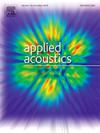Adaptive active control of underwater low-frequency radiated noise based on acoustics energy flow method
IF 3.4
2区 物理与天体物理
Q1 ACOUSTICS
引用次数: 0
Abstract
An adaptive control method is proposed to suppress far-field, low-frequency noise radiated from underwater target structures, with the normal sound energy flow in the structure's near field as the control target to reduce far-field radiated noise. An APSO-LM-BP neural network (APSO = adaptive particle swarm optimization; LM = Levenberg–Marquardt; BP = backpropagation) optimization algorithm is employed to train on sample data on the basis of placement of secondary sound sources and error sensors, establishing a mathematical model between the positions of the secondary sound sources, error sensors, and radiated sound power of the sound field after control. Numerical simulations and lake experiments are conducted on a double-layer, ribbed, cylindrical shell model. The results indicate that the neural network accurately predicts placement positions of secondary sound sources and error sensors and that the optimized placement strategy achieves effective global noise control in the low-frequency range. In addition, with increasing frequency, noise control can be achieved in specific regions, but total radiated sound power decreases with increase in number of secondary sources and error sensors.
求助全文
约1分钟内获得全文
求助全文
来源期刊

Applied Acoustics
物理-声学
CiteScore
7.40
自引率
11.80%
发文量
618
审稿时长
7.5 months
期刊介绍:
Since its launch in 1968, Applied Acoustics has been publishing high quality research papers providing state-of-the-art coverage of research findings for engineers and scientists involved in applications of acoustics in the widest sense.
Applied Acoustics looks not only at recent developments in the understanding of acoustics but also at ways of exploiting that understanding. The Journal aims to encourage the exchange of practical experience through publication and in so doing creates a fund of technological information that can be used for solving related problems. The presentation of information in graphical or tabular form is especially encouraged. If a report of a mathematical development is a necessary part of a paper it is important to ensure that it is there only as an integral part of a practical solution to a problem and is supported by data. Applied Acoustics encourages the exchange of practical experience in the following ways: • Complete Papers • Short Technical Notes • Review Articles; and thereby provides a wealth of technological information that can be used to solve related problems.
Manuscripts that address all fields of applications of acoustics ranging from medicine and NDT to the environment and buildings are welcome.
 求助内容:
求助内容: 应助结果提醒方式:
应助结果提醒方式:


